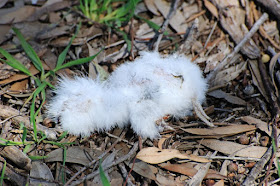
The weather is warming up now with a predicted high of 35 degrees tomorrow. The cicadas are singing loudly, very loudly, and most of the birds have fledged their young. Two late frogmouth nesting attempts have failed. I suspect the eggs were infertile as the birds had been sitting on them for longer than the usual incubation period with no sign of chicks hatching. There are chicks in two other nests and one pair are sitting on their third clutch of eggs having failed to rear chicks from two earlier attempts.
While checking one of these nests, I walked past a tree where Anthony had owlet nightjars last month. And there was a bird sitting at the entrance to one of the holes. It ducked back a little more into the hole as I approached, but stayed there looking out. These birds favour trees with multiple holes or with other suitable holes in trees within fifty or a hundred metres. If flushed by a predator they dart from one to another, with a confidence that says they know exactly where they are going.
 I left this bird at peace and wondered at its plumage and posture. The big black eyes look so like knot holes in the tree and the stripes on its head blend well with the crack lines. Perfect camouflage. Or have they adapted a plumage pattern similar to that of sugar gliders which are common in the same habitat, and so gain benefit of less predation. The central stripe over the head, round face and large eyes all fit. Perhaps potential predators are less likely to attack a glider, e.g. a sparrowhawk which only take birds.
I left this bird at peace and wondered at its plumage and posture. The big black eyes look so like knot holes in the tree and the stripes on its head blend well with the crack lines. Perfect camouflage. Or have they adapted a plumage pattern similar to that of sugar gliders which are common in the same habitat, and so gain benefit of less predation. The central stripe over the head, round face and large eyes all fit. Perhaps potential predators are less likely to attack a glider, e.g. a sparrowhawk which only take birds.






















 These birds stooped aggressively at Victor as he abseiled down to the nest for the chicks.
These birds stooped aggressively at Victor as he abseiled down to the nest for the chicks.  Then again when he went down a second time to return the chicks.
Then again when he went down a second time to return the chicks.
























